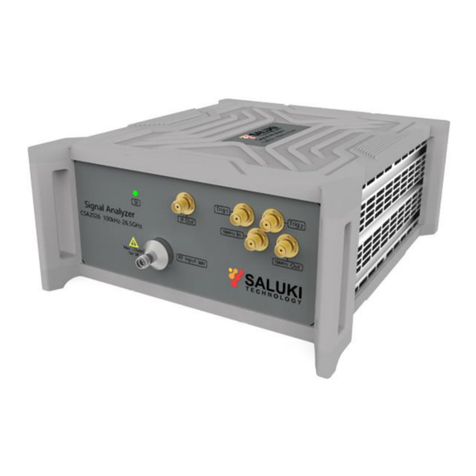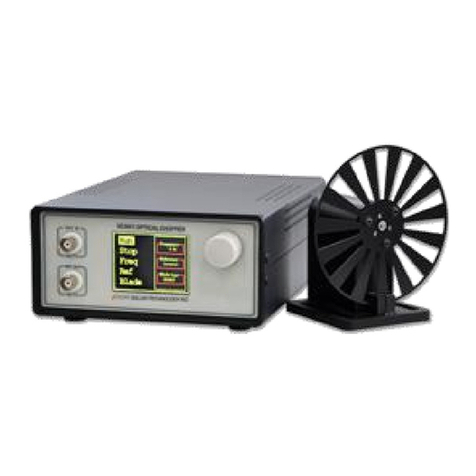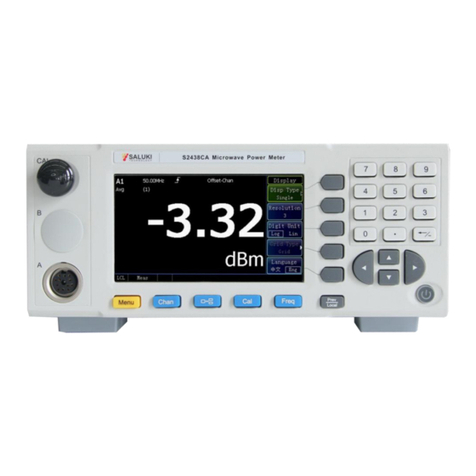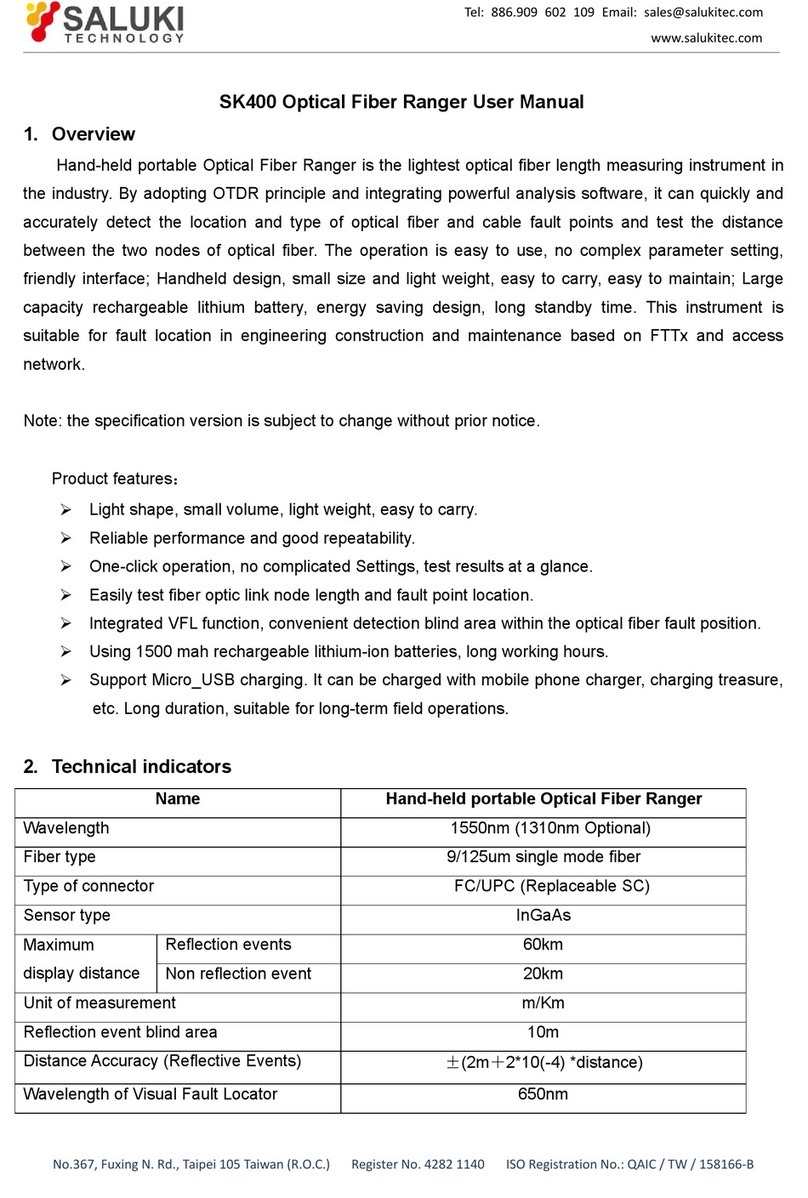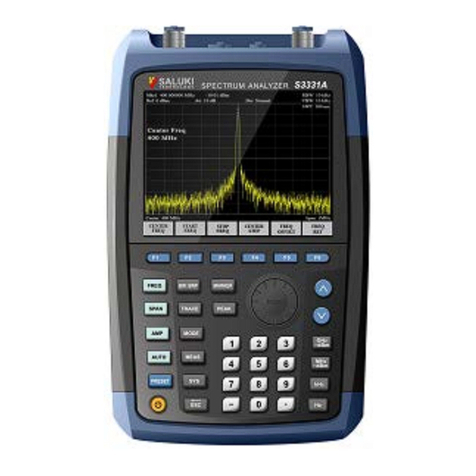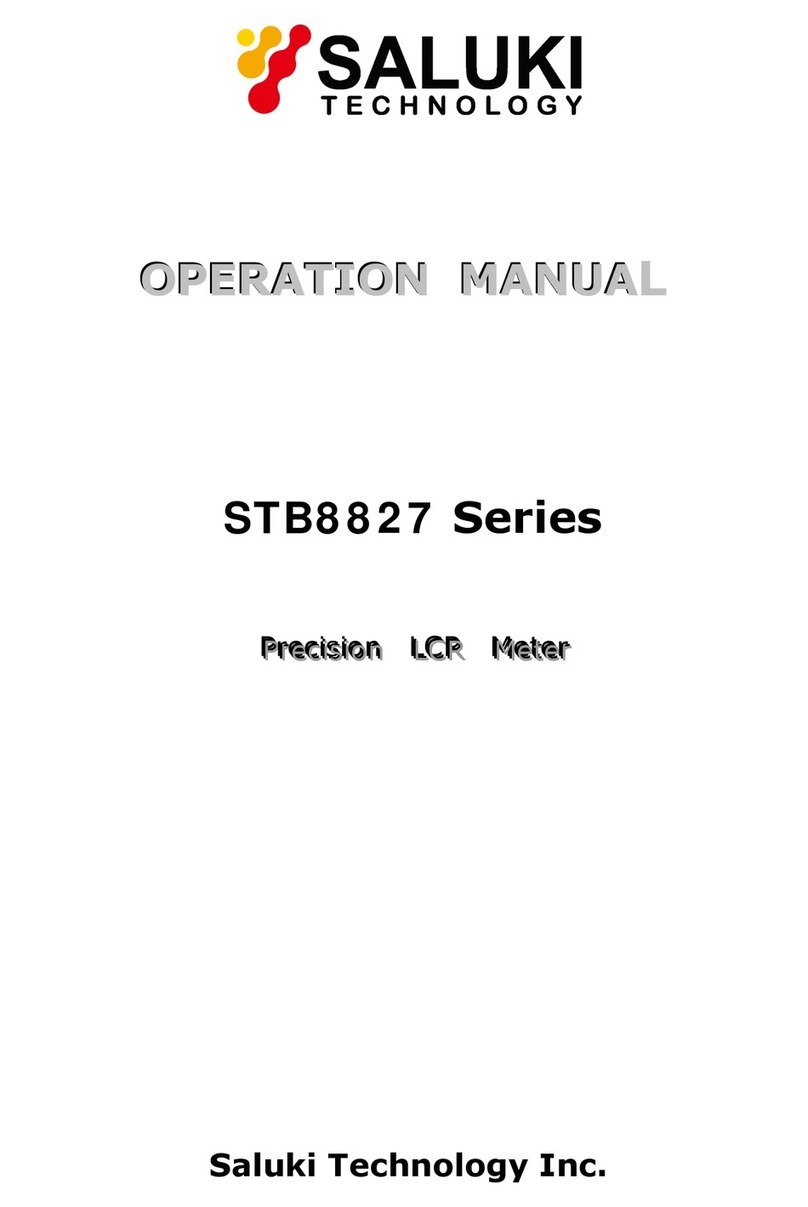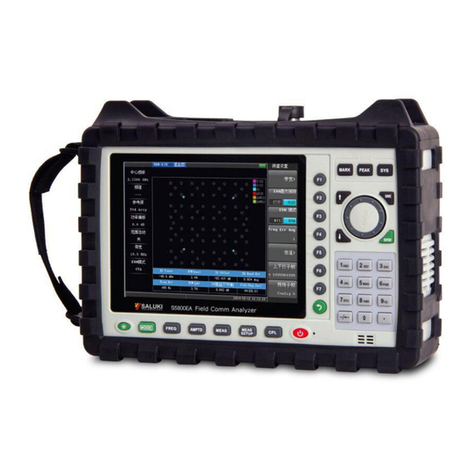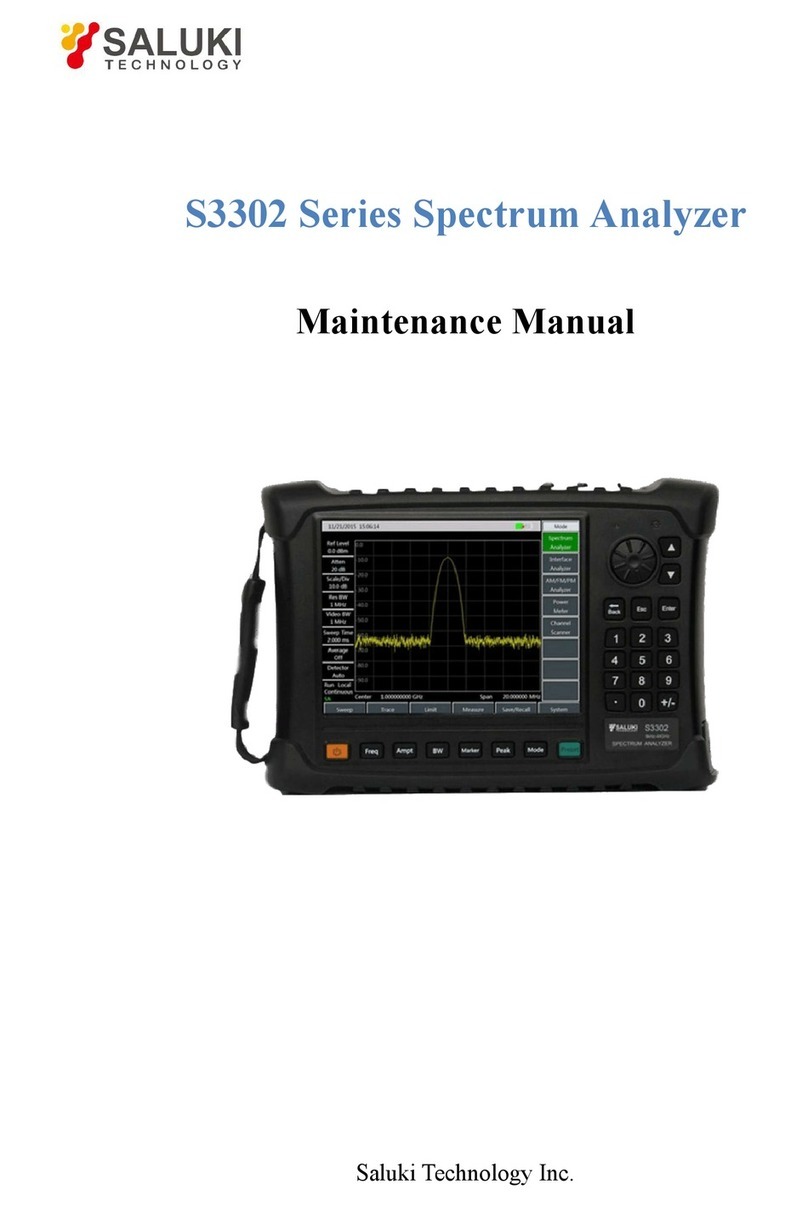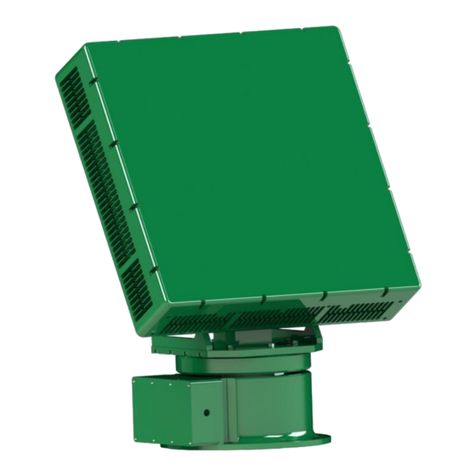
Shortcut menu
Date &Time
Flashlight
Battery
TF card
Enter the main menu after power on, there are 12
function modules. Press the direction key to select the
module, and then press the "OK" key or directly press
the function icon to enter the corresponding function
interface.
Press the "Shortcut menu" icon to enter the quick
operation menu, and press different function icons to
enter the corresponding function interface or realize the
corresponding operation function.
Print Screen: Capture the current interface, the picture
is automatically saved in the instrument, and the file
name is the time when the screenshot is generated.
OTDR is an optoelectronic integrated instrument made
of Rayleigh scattering and Fresnel reflection when
optical signal is transmitted in optical fiber. It is widely
used in the maintenance, construction and monitoring
of optical cable lines. It can measure the length of
optical fiber, transmission attenuation of optical fiber,
attenuation of connector and fault location.
Auto OTDR: it only needs to set the wavelength and
measurement time, and other parameters are automat-
ically selected by the instrument to complete the test.
For the specific meaning and explanation of each
parameter, please refer to "expert OTDR".
Expert OTDR: parameters such as wavelength, test
range and pulse width shall be set.
The test results are more accurate by selecting the
appropriate measurement parameters in the expert
mode. You can zoom in on the curve to see the details of
each event.
Wave: the emit wavelength, which can be measured at
1310nm or 1550nm.
Test range:range setting is based on the actual length
of the optical fiber to select the corresponding
predefined range, must be greater than the length of the
measured optical fiber, usually required to be set to
about twice the length of the measured optical fiber.
Auto test: OTDR automatically matches the most
suitable parameters for the current test, and the select-
ed values of test range and pulse width cannot be
modified.
Manual mode: set the value of measurement range and
pulse width manually.
Pulse width: refers to the time width of the optical
pulse signal emitted during test. The larger the pulse
width, the stronger the optical power injected into the
optical fiber, the stronger the backscattering signal of
the optical fiber is, and the farther the effective detec-
tion distance of the OTDR can be. However, the large
pulse width will cause saturation of the initial reflection
signal and a large blind area. The choice of pulse width
is related to the length of the optical fiber. The longer
the length, the larger the pulse width, which can only be
modified in real-time/average measurement mode.
Threshold settings
Event loss threshold: set the loss threshold of connec-
tion point, fusion point or macro bend in the link that
can be tested, between 0.2~30dB, and the default value
is 0.2dB. Events larger than the set threshold will be
listed in the event table, or those will be ignored.
Reflection threshold: set the return loss threshold of
the link reflection events that can be tested, ranging
from 10dB to 60dB, and 40dB by default.
End threshold: set end loss at the end of the link that
can be tested, ranging from 1~30dB, 10dB by default.
Eligibility criteria
Set the judgment value for the average loss of connec-
tion/fusion/bending/link. If it is less than the value, it is
judged as "PASS", otherwise it is "FAIL".
Connection loss: reflection event, refers to flange, SC,
LC and other joints;
Welding loss: non reflective event, refers to fusion;
Bending loss: non reflective events caused by fiber
bending, need to be tested at two wavelengths at once;
Average loss: the loss value per kilometer of the link
under test.
Select correct parameter, the test results such as curve
and event list will be displayed after test completed.
IOR: provided by optical cable or fiber manufacturer.It is
the key parameter for calculating the distance, and can
not be set arbitrarily.
Test time: it is used in the average test mode. The longer
the test time is, the better the signal-to-noise ratio of the
signal is improved, and the more accurate the test result is.
The user should choose the test time reasonably. It is
proportional to the dynamic.
Unit: select the required unit, there are three options for
km/kfeet/miles.
Charging indicator
Power on status indicator
press less than 2s to turn on the machine, pr.ess more than
2s to pop up the shutdown confirmation pop-up window;
When power on, short press to turn on or off the flashlight.
Direction key up, down, left and right
SET key enter the OTDR parameter
setting interface
ESC key exit current function
Zoom control / AB cursor switch key
Test / Stop key
OTDR: press to start or stop test
Flashlight
RJ45 Cable Tracker port
OTDR/LS port Dust cover
4.3 inch color LCD
Function keys
Top
Bottom
Main view
OPM port
VFL port
PREFACE
This series of OTDR is a multi-functional optical measuring instrument, which integrates auto OTDR,
expert OTDR, event map, optical power meter, visual fault location, power adjustable stable light
source, end face detection, optical loss test, cable line length / sequence test, cable tracking and
other functions. It has touch screen and heys. It is the right assistant for optical cable construction,
installa-tion and maintenance, project acceptance and on-site repair.
When using the instrument, do not look directly at the laser output port or the end of the optical fiber
with your eyes, avoid eye damage! Except for 1625nm/1650nm, all the others are off-line test wave-
lengths, which will cause damage to internal components of the instrument if forced to use! Any
change or modification not explicitly permitted in this manual will deprive you of the right to operate
the equipment. To reduce the risk of fire or electric shock, do not expose the equipment to thunder-
storm or humid environment. In order to prevent electric shock, please do not open the shell. It must
be repaired by qualified personnel designated by the manufacturer
Battery: the battery is a special polymer lithium battery, the charging voltage is 5V/2A, and the
charging temperature range is 0 ℃~ 50 ℃. When the ambient temperature is too high, the charging
will automatically terminate. The battery should be charged every one month to avoid long storage
time and failure of battery due to self discharge. The temperature range of battery during long-term
storage is: - 40 ℃ ~ 50 ℃.
Please use the special adapter attached with the instrument box and use the external power supply
in strict accordance with the specifications, otherwise the equipment may be damaged.
End Face Cleaning: Before testing, clean the end face of the tested fiber joint with alcohol cotton.
LCD screen: the display of this series of instruments is 4.3 inch color LCD. In order to maintain good
viewing effect, please keep the LCD screen clean. When cleaning, wipe the LCD screen with soft fabric.
Summary
Thank you very much for purchasing and using this series of optical time domain reflectometers.
This manual mainly contains the common operation and maintenance information of the instru-
ment, as well as the common troubleshooting guide and other information. In order to facilitate
your use, please read the contents of this manual carefully before operating the instrument, and
follow the instructions of this manual correctly.
This manual is only used with this instrument. Any company or person is allowed to tamper, copy
and disseminate the contents of this manual for commercial purposes without the authorization
of the company.
The contents of this manual are subject to change without notice. If you have any questions,
please call the supplier, we will provide you with the best service!
SET ESC
ON
CHARGE
1.
Auto OTDR
System
Expert OTDR Event Map
End Face
Inspector
File
Management
Optical
Loss Test
OPM
dB/dBm/mW
VFL
650nm
Home 2020-10-20 09:25
Laser Source
RJ45 Sequence
RJ45 Length
RJ45
Digital Tracker
2020-10-20 09:25
AUTO
Auto test
Menu
Home FlashlightVFL
File Print Screen Power Off Exit
0.0 10 20 30 40 50 60 70 80 90
4.0
8.0
12.0
16.0
20.0
24.0
28.0
32.0
/dB
/km
1310nm 5s
Auto test 1550nm 100km 10000ns
AutoTest
Settings
Exit
Zoom
Files
Save
Test
5.
Expert OTDR
6.
Parameter setting
4.
Auto OTDR
3.
Main interface
2.
Function keys
1.
Host
Cursor A
0.0
4.0
8.0
12.0
16.0
20.0
24.0
28.0
32.0
/dB
/km
37.56813m 19.256dB 71.25212m 10.251dB
AB
Auto test 1550nm 100km 10000ns
1550nm 10000ns Real Test
Avg. Test
AutoTest
100km 5s
1:1
1310nm
Wave
1550nm
Wave 1310nm
10000ns
5s
64km
Range
Pluse Width
Avg. Time
Refractive Index
0km
0km
Transmitting cable
End cable
kmUnit
2020-10-20 09:25
Test settings
Exit
Test
Settings
Pass
Criterion
Analysis
Threshold
Default
8.
OTDR-Curve
7.
Threshold/Criterion
9.
OTDR-File save
10.
File Operation
Settings
Exit
CursorA
Zoom
Files
Save
Curve zoom
Press the [zoom] menu to enter the zoom in and zoom
out mode.
/ Zoom in or out in X direction
/ Zoom in or out in Y direction
Press [1:1] to return to the original scale display
Event list
List: the tested results are displayed in the form of a list.
Total length: the total length of the link under test.
Total loss: the total loss of the link under test.
Slope: the loss per kilometer of the link under test.
Total events: the total number of events, the number of
passed events and the number of failed events of the
link under test.
In the event list:
NO.: the order of the current event.
Type: the type of the current event.
Distance: the location of the current event.
After the measurement, press [save] to save the file,
enter the file name, and press [enter] to save the file.
You can also press [Fastsave] to save the file. The file is
saved in a folder named the same day’s date.
Auto save: open the auto save function, the file name
will be automatically generated according to the rules;
File naming method (only valid for "auto save" and
"one click save"):
①+④: file name + fiber number naming, fiber number
increasing in order;
①+②+④: file name + wavelength + fiber number
naming, fiber number increasing in order;
①+②+③+④: file name + wavelength + pulse width +
fiber number, and the fiber number increases in order.
File name: enter the file name manually;
Optical fiber code ID: the optical fiber number and
code set when the line is initially laid;
Location A:Link start point location
Location B:Link termination point location
Direction:Optical fiber test direction,from A to B,
from B to A;
Operator: enter the name of the tester.
File operation
All the test curves are saved in the standard SD
card of the instrument. Press [File] to enter the
file operation interface. You can open, delete and
rename files.
Segment: the distance between the previous event and
the current event.
Loss: the loss of the current event.
Total loss: the loss from the starting point to the current
event.
Slope: the loss per kilometer from the starting point to
the current event.
Reflection: the return loss of the current event.
Back
File naming
Naming Type
File name
Autosave Yes
Fiber ID
Location A
Location B
Direction
Operator
otdr
2020-10-20 09:25
Save
① + ④
① + ② + ④
① + ② + ③ + ④
① File name
② Wavelength
③ Pulse Width
④ Fiber ID
Back
Select all
Rename
Delete
Storage Card
20200702
20200521
20200929
2020-10-20 09:25File Operation
Device Catalog File List
20200421
File name
76 Files
Date
Page 1 / of 8
No.
20200421-1318OTDR.bmp 2020-04-21 13:18
2020-04-21 13:25
2020-04-21 13:27
OTDR-1550-500ns-001.sor
OTDR-1550-500ns-002.sor
1
2
3
2020-04-21 13:32OTDR-1550-500ns-003.sor
4
2020-04-21 14:42OTDR-1550-2000ns-001.sor
5
2020-04-21 14:58OTDR-1550-2000ns-002.sor
6
2020-04-21 15:26OTDR-1550-2000ns-003.sor
7
2020-04-23 16:32OTDR-1550-5000ns-001.sor
8
2020-04-23 16:45OTDR-1550-5000ns-002.sor
9
2020-04-23 16:56OTDR-1550-5000ns-003.sor
10
Please do not make online test except online wavelengths!
OTDR&LS
VFL OPM
⑤
⑤
⑥
⑦
⑧
⑦ ⑧
⑥
RJ45 Sequence/Length port
RJ45 Sequence test remote
TF card
Type C USB
⑤
⑤
2020-10-20 09:25
Test Settings
Auto
Event Loss Thre.
Customize
Loss Threshold Auto
Auto
Auto
Reflectance Threshold
End of Fiber Threshold
Backscatter Coefficient
0.20dB
Test
Exit
Settings
Analysis
Threshold
Default
Pass Criterion
Pass Criterion
2020-10-20 09:25
Test Settings
Connection Loss 0.20
dB
Splicing Loss 0.20dB
Average Loss
1310nm
1550nm 0.25dB
0.40dB
Bending Loss dB
Link Loss dB
3.00
32.00
1 37.56813 0.00000 8.176 0.195 40.22
0.85
2 71.25212 33.68399 15.418 0.215 43.26
--
NO. Type Distance km
Section(km)
Loss dB Total-L dB Avg.L dB/km
Return dB
10 20 30 40 50 60 70 80 90
0.0
4.0
8.0
12.0
16.0
20.0
24.0
28.0
32.0
/dB
/km
37.56813m 19.256dB 71.25212m 10.251dB
AB
平均 1550nm 100km 10000ns
1:1
10 20 30 40 50 60 70 80 90
0.0
4.0
8.0
12.0
16.0
20.0
24.0
28.0
32.0
/dB
/km
37.56813m 19.256dB 71.25212m 10.251dB
AB
Auto test 1550nm 100km 10000ns
1:1
10 20 30 40 50 60 70 80 90
Due to the need of design improvement, the contents are subject to change without notice.
SET ESC
ON
CHARGE
ON
CHARGE
The curve and event list are displayed
at once.
Link results are summarized to a list.
Switch to event icon display mode.
Save current curve file quickly.
Enter parameter setting interface.
Warning
Attentions
According to the OTDR waveform, combine
with the direction key operation; In the
switch curve scaling, A/B cursor movement
function.
Power ON/OFF key
Attention
Please do not make online test except online wavelengths!
Attention
Curve List Event Map FastSave FastSet
Section km
Test
Settings
Analysis
Threshold
Default
Exit
Settings
Exit
Zoom
Files
Save
FastSet
FastSet
Curve
Curve
List
List
Event Map
Event Map
FastSave
FastSave
Settings
Curve List Event Map FastSave
Pass
Criterion
Pass
Criterion
S2106S
S2106S
